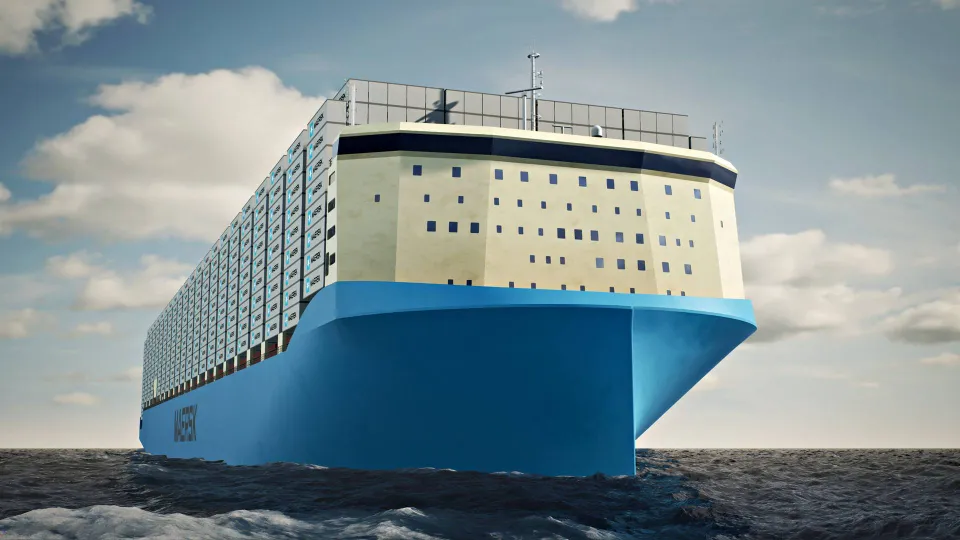If Danish project developer European Energy is to uphold its agreement with container line Maersk on delivery of 300,000 tonnes of methanol as of 2025, it could require a few billions in local currency. ”It’s no secret that we’re very busy,” PtX head tells WPO.

Photo: Maersk
Danish renewable energy project developer European Energy will need to spend a very large sum to be able to supply up to 300,000 tonnes of methanol a year for use by container line Maersk’s future fleet of methanol-powered ships.
”We’re talking quite a few billion kroner [DKK, -ed.],” says Emil Vikjær-Andresen, head of Power-to-X (PtX) at European Energy, in an interview with WPO.
European Energy has entered an agreement with Maersk to supply 200,000-300,000 tonnes of methanol a year from late 2025. But the company has already signed up to supply 10,000 tonnes a year to what will be Maersk’s first methanol-powered ship, which is scheduled to hit the water as early as next year.
With the plant sizes we’re planning in North and South America, the sum easily comes to a few billion kroner
Emil Vikjær-Adresen, head of PtX, European Energy
Here, European Energy has invested up to DKK 2bn (USD 296m) in a combined solar farm and PtX plant in Kassø, Denmark, which is to produce methanol. The facility will be able to supply 32,000 tonnes of methanol a year, with around half of the alternative fuel earmarked for Maersk.
”Of course, we hope to make things a little cheaper as we scale up production. But with the plant sizes we’re planning in North and South America, the sum easily comes to a few billion kroner,” says Vikjær-Andresen.
European Energy doesn’t disclose exactly how much money will be invested in the upcoming project. However, a calculation based on how much production is to be scaled up and without potential rebates provides a figure in the region of DKK 18bn.
Very busy
Shipping companies like Maersk that want to start sailing green as soon as possible will need to make sure alternative fuels are available for their vessels.
To that end, Maersk announced on March 10 six new partnerships with energy companies, including European Energy, which are expected to supply a total of 730,000 tonnes of methanol by the end of 2025.
Danish power company Ørsted is also among the partners, likewise set to supply 300,000 tonnes of methanol per year in 2025. However, the company declined to tell WPO how large an investment is required, only that it is a ”significant investment in the billions.”
While European Energy is already active in the Brazilian solar and wind markets in particular, which could provide a starting point for methanol production, this new deal with Maersk means that PtX projects will also be developed in the US.
Maersk’s suppliers of green methanol
Six partners will supply a total of 730,000 tonnes of green methanol per year as of the end of 2025 to Maersk’s forthcoming fleet of container ships capable of sailing on the sustainable fuel.
Ørsted, European Enrgy and Proman stand to be the largest suppliers of green methanol to Maersk at the end of 2025.
Two Chinese Maersk partners, Cimc Enric and Green Technology Bank, will be able to supply large amounts after 2025.
Maersk’s final methanol partner, Wastefuel, is an energy company in which Maersk has invested via its venture firm.
The planned delivery of a total of 730,000 tonnes is significantly more than Maersk needs for its 12 methanol vessels currently under construction, according to the carrier.
The deal sees European Energy getting quite busy as the production facilities as well as new wind and solar farms must be built and established by 2025.
”It’s no secret that we’re very busy,” says Vikjær-Andresen.
Unfamiliar volume
According to Vikjær-Andresen, the future production facilities in North and South America will be tied to projects already in the company’s pipeline, just as solar farms will form the main electricity source for methanol production.
”The exercise is to manage your supply chains, because by their nature, you need even more CO2 and ’long-lead items’ [goods that take a long time to deliver, -ed.] when you build these plants. These are important pieces to have in place,” says Vikjær-Andresen.
European Energy doesn’t yet have any final deals on the production of 300,000 tonnes of methanol per year, but the company says development of the wind and solar projects is far advanced, and the rights have been secured.
The industry isn’t used to having to supply the volume that we’re talking about here
Emil Vikjær-Adresen, head of PtX, European Energy
For the Kassø production plant, the company has taken measures including placing a large order with Siemens Gamesa, which will provide electrolysis.
”The supply chains for PtX are only just being built. The order with Siemens [Gamesa, -ed.] is the largest they have ever had. The industry isn’t used to having to supply the volume that we’re talking about here.”
A scarce commodity
Independent body the Danish Council on Climate Change recently highlighted in a report that methanol could become a scarce resource in the long term. According to Vikjær-Andresen, it’s unlikely that the entire shipping industry will be able to run on green methanol, but it will require several different types of fuel.
”No one is going to put all their eggs in one basket. But there will be several different fuels, including ammonia to supplement methanol,” he says.
”Everything can become a scarce commodity in time, but things will adjust at some point. Obviously, if the whole shipping industry has to switch from fossil fuels to green fuels, CO2 [used to produce methanol and other substances, -ed.] could become scarce.”





